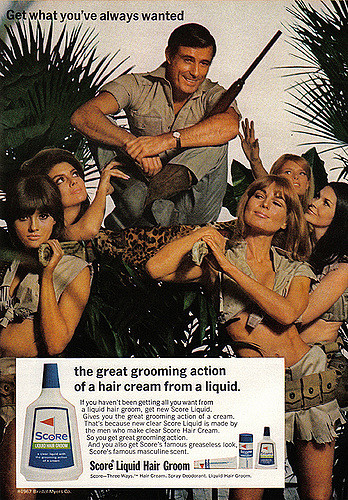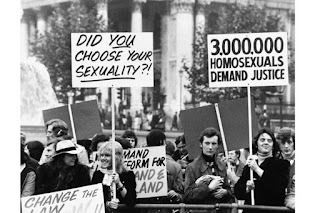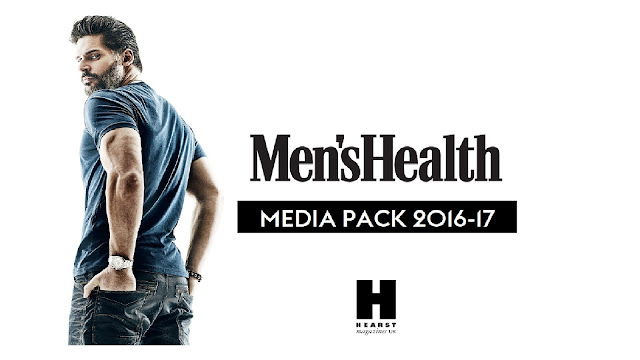Advertising: Score case study and wider reading
Answer the following questions to ensure you have a comprehensive textual analysis of the Score hair cream advert:
1) What year was the advert produced and why is the historical context important?
The advert was produced and released in 1967. This was seen as a period of change in the UK in regards to the changing attitudes towards the role of women and men in society.
- The equal pay act was introduced in 1970
- Homosexuality was decriminalised in 1967
- The contraceptive pill was introduced around this time
- This period is known as the 'swinging 60s'- where drugs and sex were at their peak
These facts are important when studying the advert as the representations depicted in the advert can be read as signalling more anxiety than might first appear. The advert may be trying to reinforce traditional stereotypes and traditions at the time in order to calm those individuals who did not like the drastic changes that were occurring.
2) Analyse the mise-en-scene in the advert (CLAMPS): how is costume, make-up and placement of models constructed to show male dominance?
Costume & makeup:
Both the male and female models are wearing clothing suited for camping or an adventure. The women are wearing short sleeved shirts that are tied up and extremely short skirts. The fact that their clothes are really revealing depicts how women were sexualised in these times and perceived as objects. The women's makeup is also quite heavy and very smoky, creating a seductive nature to the advert and reinforcing the male gaze.
Setting:
The setting has been created to be harmonious with the costume choices of the advert. The advert seems to be set in a jungle. This represents Britain's colonial values and the British Empire that was slowly starting to fall apart at the time of the release of this advert. Perhaps the producers chose to set it here to reassure the public that Britain is still in power of many other countries when it really wasn't. Furthermore, the jungle is a dangerous place that requires a tough male character. This reinforces the extreme heterosexuality of the advert.
Props:
The main prop in the advert is probably the gun that the male model is proudly holding. This creates a traditional view of men where they are expected to be strong, brave and protective. The gun makes him appear powerful which depicts men as the dominant ones in society. However, it can also be depicted as a phallic symbol that informs the male target audience that the score hair cream will give them women and pleasure.
There is also a pedestal that the women are carrying the male on. This alludes to the fact that men are above women n society and should therefore be served by women.
Actors (placement & movement):
The most obvious point is that there are 5 women in the advert while there is only one male. This would attract a male audience to the Score hair cream as they are made to believe that having good hair will make them attractive to women- and that is what they want. Three of the females are completely focused on the male character- either staring at him, desperately trying to touch him or admiring him. The model on the left is the only one not looking at him, instead she is staring directly at the camera. This creates eye contact with the audience and suggests to them that using the Score hair cream meas 'this could be you' in this current situation.
It is also important to note that all of the models seem to be British and are all white. This is probably due to the fact that racism was still around around the time of this advert. Furthermore, the male model has muscular, hairy arms which further creates an extremely heterosexual advert.
Lighting:
Bright lighting is used, probably to convey the hot weather and scorching sun of the jungle.
3) The main slogan is: 'Get what you've always wanted'. What does this suggest to the audience and how does it reflect the social and cultural context of 1967?
This slogan suggests to the target male audience that using the Score hair cream will result in you becoming extremely attractive to women. The fact that this is 'what [they] always wanted' suggests that being swarmed by women was something men took pride of in the 1960s and it is what they dreamed of. They also want to be very powerful and dominant compared to the women.
4) Why is it significant that the advert text says it is "made by men" and that it also contains "Score's famous masculine scent"?
The fact that the hair cream is 'made by men' makes the cream seem more reliable to a male audience of the 1960s. This is because it means that no hint of femininity would have been 'accidently' gotten in to the hair cream. It is completely 'women-free' but contains a masculine scent that will attract women.
5) What representation of sexuality can be found in the advert?
The use of revealing clothing for the women and the use of the gun.
6) How does the advert reflect representations of masculinity in advertising 50 years ago?
Men were represented as being extremely heterosexual, dominant and powerful in advertising 50 years ago. They were depicted to be in power of women and women were expected to do everything for them.
7) How much do you think things have changed with regards to representations of masculinity in advertising?
I think that the representation of masculinity in advertising has changed to some extent. On one hand men aren't represented to be be more powerful or dominant than women, they are more equal now. However, men are now being sexualised as well- they appear in adverts half naked and are photo-shopped to be extremely muscular and big. This means that there is still an expectation for men to be strong and powerful. Also, most of the time, a product (such as perfume) will be advertised to show the audience that using the product will get you a woman. Look at the examples below-
However, recently there has been new advertising campaigns that are trying to create a new approach to masculinity and what it means to be a man. As we can see from the adverts below, a more fatherly and gentle representation of men has been created.
The Drum: This Boy Can article
Read this article from The Drum magazine on gender and the new masculinity. If the Drum website is blocked, you can find the text of the article here. Think about how the issues raised in this article link to our Score hair cream advert CSP and then answer the following questions:
1) Why does the writer suggest that we may face a "growing 'boy crisis'"?
The writer suggests that we may face a 'growing boy crisis' because of the fact that men are hardly ever empowered in advertising compared to women. Society is aware of how to deal and talk about issues that effect women but the same can't be said for men.
Men are expected to know how to deal with issues themselves and 'be a man' when the reality is that men commit suicide more than women, and are more likely to drop out of education and get involved in crime, drugs and binge-drinking.
2) How has the Axe/Lynx brand changed its marketing to present a different representation of masculinity?
After undertaking a large-scale research project, Lynx/Axe found that men are craving a more diverse and new meaning of what it means to be a man. Therefore, Lynx/Axe introduced the 'Find Your Magic' campaign, illustrating men in a completely different light then they were previously famous for.
Lynx/Axe old campaign- 'The Axe effect'
Typical representation of men where they are surrounded by women.
 Lynx/Axe new campaign-
Lynx/Axe new campaign-'Find your Magic'
A new representation of men where they are focusing on themselves rather than on women.
3) How does campaigner David Brockway, quoted in the article, suggest advertisers "totally reinvent gender constructs"?
David Brockway suggests advertisers should 'totally reinvent gender constructs' because he fears that the body image of men is following the same negative path that females have gone through. He suggests that advertisers should create a world were stereotypes don't exist- for example, boys like pink and don't like going outside and playing football in the mud.
4) How have changes in family and society altered how brands are targeting their products?
Family life and society has now changed in a way that means males are doing the household shopping just as much as females are. Statistics show that, in some countries, men are doing 40% of the shopping. This means that brands have to change their advertising to be aimed and suited at both males and females and represent this new society otherwise they are losing out on valuable customers.
5) Why does Fernando Desouches, Axe/Lynx global brand development director, say you've got to "set the platform" before you explode the myth of masculinity?
Fernando Desouches suggests that 'setting the platform' means giving society what they are used to- an advert with extremely attractive males who are well built. This gains the attention of the audience. After the attention has been established, you can 'explode the myth' by showing men that they can be whoever or whatever they want to be and still gain support.
Campaign: Why brands need to change
Read this Campaign article on Why brands need to change their approach to marketing masculinity. If the Campaign website is blocked, you can find the text of the article here. Think about how the article relates to our work on gender and advertising then answer the following questions:
1) What are two ways advertising traditionally presented masculinity?
- A glamorous James Bond-style masculinity that attracted ‘the ladies’
- A buffoon-style masculinity that was firmly under the wifely thumb
- Altruistic- traditional masculinity causes problems for both the wellbeing of men and women.
- Self-serving- masculinity is constantly shifting and brands need an equally agile response in order to engage with consumers and remain relevant and competitive.
- Stage 1- "unconscious masculinity"
People live their lives according to what they think is 'common sense' and do not question masculinity. They believe in traditional masculine stereotypes but this is unconscious.
- Stage 2- "conscious masculinity"
People choose to follow the traditional stereotypes of masculinity consciously. They usually look to various "proofs" of masculinity, such as historical evidence, biological determinism or even holy books.
- Stage 3- "critical masculinities"
Similar to feminism. People are aware of the fact that their society is often patriarchal and homophobic and want to counter these problems. They also tend to believe that gender roles are socially constructed rather than biological.
- Stage 4- "multiple masculinities"
Suggests that masculinity can mean anything to anyone. People at this stage focus on the freedom to be who they want to be.
- Stage 5- "beyond masculinities"
Proposes the simple truth that masculinity does not exist. People at this stage believe that masculinity in an illusion created in society to keep control of people.
4) Take the Five Stages of Masculinity Personality Inventory test to see what stage of masculinity you are at. Where did it suggest your views are currently? Do you agree with its assessment? You can read more about the five stages of masculinity here.
The five stages of masculinity stated that I am on stage 3 of The Five Stages of Masculinity. I don't agree with this assessment because I wouldn't say that I am an active feminist and I'm not sure where I stand on the thought that gender roles are socially constructed rather than being biological.
5) What stage of masculinity was the Score advert aiming at in 1967?
The Score advert was aiming at stage 1 of the five stages of masculinity.
6) Why are the stages of masculinity important for companies and advertisers when targeting an audience?
The five stages of masculinity is important for companies and advertisers when targeting their audience as they will be aware of the beliefs of that audience, meaning they can create campaigns that are parallel with those beliefs and therefore attract that audience to their product.











Path of Exile: Scourge will be released, players can prepare enough POE 3.16 Currency to make it easier to build an advantage in the game.
ReplyDeleteAttached link: https://www.poecurrency.com/
Buy Now & Save!
ReplyDeleteSnovitra 10, with Vardenafil 10mg, is a reliable choice among erectile dysfunction pills. It helps improve blood flow to the genital area, enabling men to achieve and maintain firm erections for a satisfying sensual experience.
Letar du efter en pålitlig butik för potensmedel? Beställ Kamagra gelé Sverige snabbt och diskret hos oss. Säker betalning och anonym leverans. Alltid bra priser och hög kvalitet. Beställ idag och upplev skillnaden.
ReplyDeleteBenieuwd naar Kamagra Bijwerkingen? Mogelijke bijwerkingen zijn hoofdpijn, blozen en een verstopte neus. De meeste klachten zijn mild en verdwijnen vanzelf. Lees altijd de bijsluiter en gebruik Kamagra verantwoord.
ReplyDeleteTwijfel je tussen Cialis of Viagra? Beide middelen behandelen erectieproblemen, maar Cialis werkt tot 36 uur, terwijl Viagra ongeveer 4-6 uur actief blijft. Kies het middel dat het beste bij jouw behoeften past. Cialis of Viagra
ReplyDeleteKamagra Oral Jelly Kaufen för en snabb och effektiv lösning på erektionsproblem. Detta gelbaserade läkemedel absorberas snabbt och börjar verka inom 15 minuter. Perfekt för män som föredrar en enklare intag än tabletter. Med olika smaker och långvarig effekt är Kamagra Oral Jelly en populär lösning. Beställ online säkert och diskret. Köp Kamagra Oral Jelly och förbättra din sexuella prestanda redan idag!
ReplyDelete